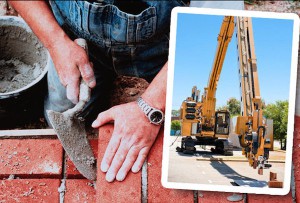By Anca Gagiuc on August 13, 2015 in Technology
There is one thing the Egyptian Pyram ids, Rome’s Colosseum, India’s Taj Mahal, and the Great Wall of China have in common: masonry. All these astonishing architectural achievements, scattered all over the globe, share the same building technique chosen for its beauty, versatility, and durability.
ids, Rome’s Colosseum, India’s Taj Mahal, and the Great Wall of China have in common: masonry. All these astonishing architectural achievements, scattered all over the globe, share the same building technique chosen for its beauty, versatility, and durability.
The level of complexity varies from simple masonry to ornate exteriors or high-rise buildings. After more than 6000 years, masonry is still used today. Just go down the street and look around at the office buildings, schools, houses, or patios and you’ll see some form of masonry.
Traditional builders are convinced that regardless of the material used – whether it is brick, block, tile, terra-cotta, or stone – the skill and precision of the mason can never be replaced by machines. One Australian engineer presented a robot that wants to prove otherwise.
Fastbrick Robotics has finished developing the robot named Hadrian (after the ancient Roman emperor Hadrian, who had a thing for construction and ordered the building of Great Britain’s famous Hadrian’s Wall). It took the engineers ten years and $7 million spent in research and development to bring Hadrian to life. Even though the robot is still in the prototype stage, Mike Pivac, an aeronautical and mechanical engineer, and the CEO of Fastbrick Robotics, hopes to bring the commercial machine onto the market within the next couple of years.
Hadrian is able to handle, process, and lay 1,000 bricks an hour, work 24/7, and complete the shell of a brick house in just two days. This means 150 homes a year! Here is god to know that a standard house takes around 15,000 bricks to develop, and about six weeks to complete through the traditional method.
The first step in putting Hadrian to work is creating the layout of the house in a 3D computer program (CAD) that does all the tricky math to figure out what size to cut the bricks and where to place them. As soon as the laser-guided system identifies where to place the bricks the building begins. At the heart of Hadrian is a 28m (92 feet) articulated telescopic boom that will deliver the mortar and places the bricks with a high level of accuracy, according to the pre-sequenced layout. The boom auto-corrects itself 1,000 times per second to prevent interference from vibrations and sway. This concept is similar to the additive manufacturing process used by 3D printers.
The machine can handle almost any size of brick available today, and from its set position it can even take into account the routing channels for the electrical and plumbing structures that need to be laid in the wall, not just the windows and doors.
Pivac claims Hadrian improves site safety, reduces the level of waste created with each house construction, and cuts down on associated emissions. Moreover, rather than taking human jobs, he hopes Hadrian creates them. Masonry is not appealing to young people, and the available bricklayers in Australia are now nearing 50 years of age. Hadrian’s bricklaying prowess could attract a younger generation, one very interested in robotics, to a traditional building trade.


